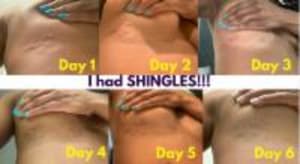
October 22, 2021 “I had Shingles”
Can y’all believe I had shingles? Like literally I still have some scarring, the nerve pain is mild but still present. I am open to share with you my experience, in hopes of lessening someone else pain or discomfort.
When I first started nursing, I would only see “OLD” people come in with shingles. And when I say old, these patients were in their 70s-90s, and they had some pretty severe cases. Now don’t get me wrong, I am not saying people of all ages cannot get shingles, because they do. However, my experience of caring for shingles patients they were all older. It was always a disease I said I would never want to get because I saw how much pain the patients were in and how severe their rashes were. But I can truly say, I was blessed, because I caught it early and because I was already in such good shape and health, I was able to fight off this virus rather quickly.
How it started and signs to catch it early
The first day I started feeling some tingling around the right side of my chest, back and thigh. I thought this is weird, why am I only having this sensation on my right side? I have never felt this discomfort before, so I took some Motrin and hydrated very well.
By day two I noticed a very small rash under my right breast. Rashes are uncommon for me, so I quickly thought, oh I must have scratched myself somehow. So, I put some Triple Antibiotic Ointment on it, and it gave me some temporary relief.
By day three I had a full rash spread from the middle of my chest radiating from under my right breast to the right side of my back. By this point I didn’t want anything touching me anywhere on the right side of my body, especially any clothing. Wearing a bra of any kind was torturous. I knew then from my nursing background that I had SHINGLES. Ugh the nerve pain was the worst, and I can take pain, Calamine lotion became my BFF. I took a video of my situation and I shared it with Dr. Monica, stating, Girrrrllllll I got shingles. And soon as she saw my video, and asked me a few questions, she was like you sure do. She called me in two prescriptions for Valtrex and Neurontin. I took the pills every 8 hours faithfully.
Mind you, I was still teaching 3 sessions a day, without my waist trainer, and in pain. I smiled and gave it my all, no mess style.
Because I started my treatment so early, I only saw one very tiny blister. I never had any weeping lesions or open sores, and my rash only lasted a total of 5 days. Thank God.
Tadda, what is Shingles?
Shingles is a viral infection that causes a painful rash. Although shingles can occur anywhere on your body, it most often appears as a single stripe of blisters that wraps around either the left or the right side of your torso, not both!
Shingles is caused by the varicella-zoster virus, the same virus that causes chickenpox. After you've had chickenpox, the virus lies inactive in nerve tissue near your spinal cord and brain. Years later, the virus may reactivate as shingles.
Eventually, it may reactivate and travel along nerve pathways to your skin producing shingles. But not everyone who's had chickenpox will develop shingles.
Varicella-zoster is part of a group of viruses called herpes viruses, which includes the viruses that cause cold sores and genital herpes. Because of this, shingles is also known as herpes zoster. But the virus that causes chickenpox and shingles is not the same virus responsible for cold sores or genital herpes, a sexually transmitted infection.
Shingles isn't a life-threatening condition, but it can be very painful. Vaccines can help reduce the risk of shingles. Early treatment can help shorten a shingles infection and lessen the chance of complications. The most common complication is postherpetic neuralgia, which causes shingles pain for a long time after your blisters have cleared.
What are some other symptoms?
The signs and symptoms of shingles usually affect only a small section of one side of your body. These signs and symptoms may include: The highlighted areas are the only symptoms I had.
· Pain, burning, numbness or tingling
· Sensitivity to touch
· A red rash that begins a few days after the pain
· Fluid-filled blisters that break open and crust over
· Itching
· Fever
· Headache
· Sensitivity to light
· Fatigue
Pain is usually the first symptom of shingles. For some, it can be intense. Depending on the location of the pain, it can sometimes be mistaken for a symptom of problems affecting the heart, lungs, or kidneys. Some people experience shingles pain without ever developing the rash.
Is shingles contagious?
A person with shingles can pass the varicella-zoster virus to anyone who isn't immune to chickenpox. This usually occurs through direct contact with the open sores of the shingles rash. Once infected, the person will develop chickenpox, however, not shingles.
Chickenpox can be dangerous for some people. Until your shingles blisters scab over, you are contagious and should avoid physical contact with anyone who hasn't yet had chickenpox or the chickenpox vaccine, especially people with weakened immune systems, pregnant women, and newborns.
Who is at risk?
Anyone who has ever had chickenpox can develop shingles. Most adults in the United States had chickenpox when they were children, before the advent of the routine childhood vaccination that now protects against chickenpox.
Factors that may increase your risk of developing shingles include:
·Being older than 50. Shingles is most common in people older than 50. The risk increases with age. I guess I kicked age 50 wide open. LOL
·Having certain diseases. Diseases that weaken your immune system, such as HIV/AIDS and cancer.
·Undergoing cancer treatments. Radiation or chemotherapy can lower your resistance to diseases and may trigger shingles.
·Taking certain medications. Drugs designed to prevent rejection of transplanted organs can increase your risk of shingles as can prolonged use of steroids, such as prednisone.
Complications from shingles can include:
·Postherpetic neuralgia. For some people, shingles pain continues long after the blisters have cleared. This condition is known as postherpetic neuralgia, and it occurs when damaged nerve fibers send confused and exaggerated messages of pain from your skin to your brain.
·Vision loss. Shingles in or around an eye (ophthalmic shingles) can cause painful eye infections that may result in vision loss.
·Neurological problems. Depending on which nerves are affected, shingles can cause an inflammation of the brain (encephalitis), facial paralysis, or hearing or balance problems.
·Skin infections. If shingles blisters aren't properly treated, bacterial skin infections may develop.
How to prevent Shingles?
A shingles vaccine may help prevent shingles. People who are eligible to get it should get the Shingrix vaccine. I can’t wait to get mine. Early detection and living a healthy lifestyle. FYI…The shingles vaccine doesn't guarantee that you won't get shingles. But this vaccine will likely reduce the course and severity of the disease and reduce your risk of postherpetic neuralgia.
Bottom line: You never know what illness or disease might come your way no matter how healthy you are, so it is best to stay ready and not always getting ready. The healthier you are going into any battle the better your experience and recovery will be. No Mess




